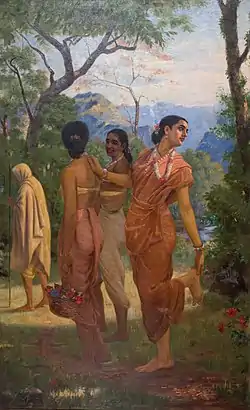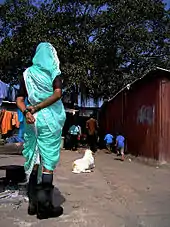Kasta sari
The Kaashtha sari (Marathi: नऊवारी साडी) is a style of sari draping is very similar to the way the Maharashtrian dhoti is worn. The word Kaashtha refers to the sari being tucked at the back.[1][2] Since this sari is usually worn by using a single nine yard cloth, it is also referred to as Nauvari which means Nine Yards.[3] Sakachcha sari is another term commonly used to refer to this style of sari.[4] It is referred to as Akanda Vastra, which means it doesn't need any other attire to support it. In fact, this attire holds utmost importance as women across different walks of life have worn it. It is not just worn at religious and cultural events, but women have fought wars in the past and still work in farmlands wearing this. [5]

Types of draping
Traditional drape
It is the traditional Marathi style of sari which is worn without a petticoat.[6] This style of sari draping is common among all the castes but the way of draping differs according to the region and topography as well. For example, Brahmin women wear it in a particular way which is called as brahmni on the other side aagri people from the raigad district wear it in a knee length fashion is called as 'adwa patal' whereas with a small variation the kunbi or the farmer women of raigad district and some parts of ratnagiri as well wear nineyard which is called as "uprati" .The name uprati means up side down which is because of some folds while draping the saree are up side down. One of the special features of adwa patal and uprati arethat these sarees are draped without tying knots but still the saree is very tightly draped. On contrary to this women from rural Puñe and Satara Ahmed Nagar or Kolhapur, wear it to the ankle length which is very popular. Also, the Brahmins wear it in a particular way where the border of the saree is displayed on the front side as well, similar to the kashta on the back Side. Some details are given below as well.[7] This sari is draped in a way that the center of the sari is neatly placed at the back of the waist and the ends of the sari are tied securely in the front, and then the two ends are wrapped around the legs. The decorative ends are then draped over the shoulder and the upper body or torso.[8] Sayali Badade, an HR executive said, "A woman who wore a Nauvari was always looked upon with respect. The reason being both the shoulders of the women are covered, and it makes for a completely traditional wear. The style was originally started and popularised from the Peshwai reign".[5]
Koli-style drape
Women of the Koli tribe also wear this style of sari but cut into two pieces. One piece is worn around the waist while the other piece is used to cover the upper part of the body. It is taken on the head over the left shoulder in the Maratha fashion.[9][10] The Koli women are decorative with both dress and ornament and this sari of nine yards of cotton fabric is draped adeptly over the hips so that the figure is graceful in movement.[11]
Usage

Traditional Usage
The traditional 'nauvari' retains its charm even in the modern age. Also known as 'Lugada', this sari is now regularly worn mostly by elderly Maharashtrian women. However, in the contemporary fashion, the trend of wearing nine-yard Kasta sari is picking up fast in the younger lot that wants to keep the age-old Marathi tradition alive. It requires perfect technique, practice and perfection to wear a nine-yard saree. Mostly worn in dance competitions, "lavani" and Maharashtrian folk dance, the Kasta sari has surely made a great come back in the fashion industry. Prashant Shalgar, a nine-yard Kasta sari seller, said, "It has always been in demand. Though earlier only elder generation women would pick up these sarees but now many young girls go for it for its elegant looks. Prashant Kolhe, a management executive, said, "My grandmother used to wear nine-yard saree. It would look great on her. She used to carry it very well. I guess Indian sarees are the best fashion wear available on the globe. You cannot look graceful, trendy and comfortable in any other dress.[12] Women dabbawalas in Mumbai are dressed in nauvari saris.[13]
Modern Usage

To make the wearing more easy and comfortable, the market is all set to sell stitched Kasta sari for those who love drape it.[14] Sandhya Kenjale, another Kasta sari seller, says, "I started stitching nineyard sarees because I could never drape it properly. For draping a nineyard saree, you should have some guidance for it is a technique to wear it. There are many occasions when women choose to wear nine-yard sarees but the drawback is they do not know the technique. Ready-to-wear nine-yard saree is the perfect solution for such problems. Just wear it like a salwar put the pallu over the shoulder and you are dressed in few minutes. Also, teen-aged girls are seen wearing it in their school or college gatherings. Many brides are now taking help of such ready-to-wear nine-yard sarees. With a wide range of them available in the market, buyers have a lot of choice. Available in Bangalore silk, Belgaum silk, pure silk, Orissa silk, nine-yard sarees are priced reasonably. "Prashant Shalgar added, "Marathi movies are responsible for keeping the traditional wear alive. To make it easy, these sarees are now stitched and sold in the market".[12] Stylist Pradnya Bhalekar stated, "You can wear a stitched Nauvari like a salwar. It is as simple as wearing your favourite pair of denims. Besides, you don't have to worry that the drape might come off".[15] Shobhaa De in her blog told that she suggested to Mukesh Ambani that the cheerleaders of Mumbai Indians can wear the traditional nine yard kasta sari and perform dance routines for the local lavani.[16]
Reduction in Usage
On the contrary, some consider the Kasta sari has fallen out of favour currently. It is considered far too revealing. It is rarely seen in the cities. This type of sari is regularly made fun of in films, portrayed as some sort of "sexy" garment, meant to titillate. In reality the Kasta sari embodies freedom for women. In a way it is similar to the dhoti as it allows leg movement and the ankles are left free. But today the Kasta sari will only be considered decent if distorted to hide every inch of a woman's body.[17]
Bollywood
.jpg.webp)
Women adorning kasta saris are seen in some Bollywood films, although mostly they are worn in song sequences. Generally, in modern Bollywood fashion, the pallu is fully wrapped around the waist rather than on the shoulder and to cover the blouse or choli, folded chunri of contrast color is pinned up. Also the hairstyle on is step-cut up to shoulder length with smart nose ring or Nath and Chandrakor Bindi.[18]
The most famous example of Kasta sari in Bollywood is the song sequence of "Humko Aaj Kal Hai Intezaar" in the film Sailaab (1990) featuring Madhuri Dixit in a yellow and green Kasta sari.[19] Another recent example is of Kim Sharma in the film Tom, Dick, and Harry (2006). She played the role of Bijlee, a fisherwoman, for which she appeared in Kasta saris of different color throughout the entire film.[20][21][22]
The first look and promos of Agneepath, the 2012 remake of the 1990 Hindi film of the same name was released which featured actress Katrina Kaif dancing for an item song "Chikni Chameli" in a yellow kasta sari.[23][24][25] Actress Vidya Balan dressed in a red kasta sari along with lavani dancers performed live on stage her latest item number "Mala Jau De" for the audience, from Vidhu Vinod Chopra's upcoming film Ferrari Ki Sawaari. She told she was inspired from Madhuri Dixit's performance from Sailaab.[26] In 2015, actressess Deepika Padukone and Priyanka Chopra featured in nauvari saris for a dance sequence in the film Bajirao Mastani.[27][28] Anju Modi, the costume designer for the film stated, "I do hope that after this movie, the nauvari saree makes a comeback".[29]
During 2016, actress Nargis Fakhri will be seen in a nauvari sari for the film Banjo for a dream sequence.[30][31]
References
- Ghurye, Govind Sadashiv (1966). Indian costume – G. S. Ghurye. ISBN 8171544037. Retrieved 2013-05-20.
- Tribhuwan, Robin D.; Finkenauer, Maike (2003-01-01). Threads together – a comparative study of tribal and pre-historic rock paintings – Robin D. Tribhuwan, Maike Finkenauer. ISBN 8171416446. Retrieved 2013-05-20.
- Ramnarayan, Gowri (1997). Past forward: six artists in search of their childhood – Gowri Ramnarayan. ISBN 9780195639391. Retrieved 2013-05-20.
- Biswas, Arabinda (1985). Indian costumes – Arabinda Biswas. Retrieved 2013-05-20.
- "Celebrate Maharashtra day by wearing a nauvari". Times of India. May 1, 2016. Retrieved 4 June 2016.
- India perspectives, Volume 12, Issues 3-12 – India. Ministry of External Affairs. 1997. Retrieved 2013-05-20.
- Ghurye, Govind Sadashiv (1966). Indian costume – G. S. Ghurye. ISBN 8171544037. Retrieved 2013-05-20.
- Barnes, Ruth; Eicher, Joanne B. (1993-04-14). Dress and gender – making and meaning in cultural contexts By Ruth Barnes. ISBN 9780854968657. Retrieved 2013-05-20.
- Prasad, R. R. (1996). Encyclopaedic profile of Indian tribes, Volume 1 – Sachchidananda, R. R. Prasad. ISBN 9788171412983. Retrieved 2013-05-20.
- Saris – an illustrated guide to the Indian art of draping – Chantal Boulanger. December 1997. Retrieved 2013-05-20.
- Mārg – a magazine of the arts, Volumes 1-2,Modern Architectural Research Group, National Centre for the Performing Arts (India). 1946. Retrieved 2013-05-20.
- "Comeback for nau-vari". Lite.epaper.timesofindia.com. Retrieved 2013-05-20.
- "Meet Mumbai's only women dabbawalas". Mid-day.com. 2004-02-24. Retrieved 2013-05-20.
- Srishti Ghosh Shinde (Sep 17, 2015). "Save time with pre-stitched nauvaris this festival". Retrieved 28 May 2016.
- "Get the right look this Gudi Padwa". Times of India. Apr 8, 2016. Retrieved 4 June 2016.
- Shobhaa De (2010-04-13). "Shobhaa De". Shobhaade.blogspot.com. Retrieved 2013-05-20.
- "Sari an immodest garment?". Nitawriter.wordpress.com. Retrieved 2013-05-20.
- Different drapping styles of Regional Sarees Archived October 20, 2011, at the Wayback Machine
- "Ten Best Picturised Songs of Bollywood". Mouthshut.com. Retrieved 2013-05-20.
- Indian Bollywood Designer Saree Collection - Gauri Khan
- "Kim Sharma plays a fisherwoman in 'Tom, Dick and Harry'". Bollywoodpremiere.com. Retrieved 2013-05-20.
- "Coming of age – Kim Sharma". Shaaditimes.com. 2008-10-17. Retrieved 2013-05-20.
- Renuka Vyavahare, TNN Dec 19, 2011, 07.11PM IST. "Katrina wows as Chikni Chameli, surpasses Sheila!". Articles.timesofindia.indiatimes.com. Retrieved 2013-05-20.CS1 maint: multiple names: authors list (link)
- "Katrina continued shooting for 'Chikni Chameli' despite an injury". Indianexpress.com. 2011-12-09. Retrieved 2013-05-20.
- "Katrina Kaif dazzles as Chikni Chameli in Agneepath". Indiatoday.intoday.in. 2011-12-15. Retrieved 2013-05-20.
- "Vidya Balan performs lavani on stage". NDTV. Retrieved 29 May 2012.
- STACEY YOUNT (November 17, 2015). "MORE ABOUT PINGA FROM BAJIRAO MASTANI". Bolly Spice. Retrieved 3 June 2016.
- moumita bhattacharjee. "Deepika Padukone and Priyanka Chopra performing Pinga in Bajirao Mastani and not lavani". bollywoodlife.com. Retrieved 3 June 2016.
- Aastha Atray Banan (November 22, 2015). "Anju Modi on designing costumes for Bajirao Mastani". Mid Day. Retrieved 4 June 2016.
- "Nargis Fakhri dons a traditional nauvari sari for Banjo!". Daily News and Analysis. 30 May 2016. Retrieved 3 June 2016.
- "Nargis Fakhri sports a nauvari in 'Banjo'". Times of India. May 30, 2016. Retrieved 3 June 2016.